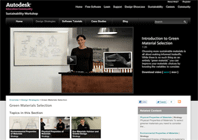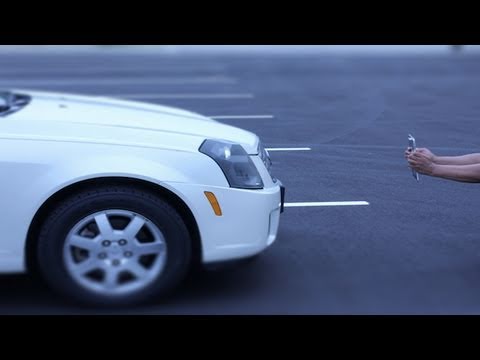We chat to Dawn Danby, Autodesk’s Sustainability Workshop head honcho about the site’s exciting new updates

For those that have been reading DEVELOP3D over the last few months, you’ll know that we’ve recently started introducing more content relating to sustainability into the magazine. If you aren’t, then its all available to read, digest and enjoy at the dedicated microsite, sustainability.develop3d.com.
As part of the preparation process, we spent a good ol’ chunk of time reading and learning ourselves and one resource which I personally found educational is Autodesk’s Sustainability Workshop. If you’ve not come across it before, this is a web-based resource that provides video tutorials to explain some pretty hefty concepts in a clear, digestible and yup, enjoyable manner. Backed up with case studies, a brief blog and if you’re registered for Autodesk’s Education materials, then you get data-sets to work with and try out.
The Workshop has just been updated with new content relating to materials selection as well as more Building design related content, so it seemed like a good idea to have a chat catch up with Dawn Danby, who leads the project at Autodesk.
Al Dean: Tell us about the Sustainability Workshop – what was the project’s genesis?
Dawn Danby: If your goal is to create things that are nontoxic, zero-waste and zero-emissions, that means that you must consider a different set of criteria, and you have to design things in new ways. Autodesk has been working on new tools to help people estimate environmental impact, but you can do a lot with the tools already at hand. The toolset is only part of the picture: the mindset also needs to change.
Sustainable design strategies are well accepted by experts, but poorly distributed among professionals and students. By and large, most universities completely ignore sustainability. Students are really open to new ways of thinking, and they’re pushing their profs to build sustainability into curriculum. Schools are training tens of thousands of students from an antiquated 19th or 20th Century mindset, an imaginary world in which resources are limitless. This lack of preparation for our century’s job market is totally unstrategic. We have over three million registered members of the Autodesk Student Community. The Sustainability Workshop was started in order fill the gap in education, recognizing that we’re already connected to students worldwide who are about to become professionals.
The other thing we wanted to address is the fact that most sustainability language is conceptual, and therefore untrustworthy, to engineers. They want a sense that environmental impact is knowable and measurable, and that they can apply their skills to solving problems. We’re aiming to connect these broad concepts to the analysis tools that students are learning to use.
AD: There’s a fantastic use of video on the site, I found that they can teach subjects that, if you try and read about them, appear way too complex for the lay person to grasp, but for some reason, video seems to hit a sweet spot where things can be conveyed that are complex, but in an easily digestible way. How do you manage to do that? Take the complex and strip it back to something that’s easily understandable?
DD: Humans always take simple ideas and make them sound complicated, or take visual concepts and abstract them into numbers. I made a rule that we strip out the jargon as much as possible. We wanted to break things down to expose their simplicity. People often don’t want to watch anything online for more than a few minutes at a time, which also forces us to keep things short.
We have some great, forward-thinking professors who are using our videos in class, yet our goal was to give students a way to quickly get up to speed on sustainable design concepts without waiting for academia to change. And then students can delve into tutorials and case studies when they want to geek out and learn more at their own pace.
We’re totally unashamed of taking inspiration from children’s television shows like Sesame Street and the Electric Company that do a really good job at explaining things in ways that stick. Mr. Imagination is an irreverent and fun gateway to thinking about sustainability. We wanted to combine storytelling and visual thinking to make ideas super accessible, which is why we partnered with Free Range Studios on making the videos. Free Range were well known for the Story of Stuff series, which explains the ecological problems in product lifecycle; we wanted to apply the same clarity of thought to explaining the solutions.
AD: I know that the resource is aimed at the student community and you have a bunch of resources that only those with an Autodesk Educational account can access (such as work files, tutorials). Any chance of opening things up to a wider audience of professionals?
DD: Honestly, almost everything is free to everyone, excepting the datasets. The videos are downloadable for Education Community members, primarily so that professors can show videos in class when they don’t have good streaming bandwidth. Aside from that, there’s really no limitation aside from the fact that they’re only in English. Anyone can watch them on their laptops, mobiles, whatever. There didn’t seem to be any value at all in restricting access. But we do feel that there should be an incentive for students and educators to sign up for the Community, besides getting access to free software.
Going wider also means having things in other languages: we have a handful of videos translated into Simplified Chinese available to students on our China Education Community, and are adding more.
We’re finding that professionals are using the videos even though we haven’t really reached out to them. Just this week we got some great feedback from architects in two major global firms. In some cases it helps them directly with their own projects, coming up to speed on sustainable design terminology and tools. In other cases, they send videos to their clients to help get them on the same page.
AD) You just added a bunch of new videos and background material – what’s coming next? Anything you can let us in on?
We just introduced a new series on net-zero energy building, the first materials on the Workshop to address architectural and building analysis using BIM. We may think of green building as being all about architecture, but I’ve met a lot of young engineering students who are really interested in building performance and who are going to become the next experts for engineering building systems.
Our first focus was on mechanical engineers and product/industrial designers who are working on smaller projects: mechanical systems, vehicles and consumer products. We’re excited to start releasing videos on greener materials selection. We’ve also really been looking forward to a series on energy later this month, since understanding energy is so central to how we address climate-related emissions.
We’re also looking forward to showcasing student projects from the classrooms using the Workshop. Consider that an open call for submissions!
If you’ve got any interest in the sustainability subject, then you’ll know that on the face of things, it seems like a complex subject, but when you dive into it, it centres on good design and engineering practice, some rethinking of how we do things (which designers and engineers do every day) and a crap load of common sense. Yes, there’s a different terminology stack bandied about, but it is accessible once you dig into it.
What impresses me most about what Autodesk are doing with the Sustainability Workshop is stripping back that complexity and presenting it in a manner that’s clear and concise and gets you up to speed quickly and in an informed manner.
If you want to learn a wee bit more, there’s a whole glut of good books out there to dig into as the darker evenings draw in. We covered some of them in the last D3D Sustainability issue and I’m going to post an update to that article too soon with a few more gems I’ve discovered or got pointed to over the summer. Also, Jer Faludi (who’s co-star in the videos) and Dawn wrote a fantastic article on Whole System Thinking in Design for the last issue and definitely worth a read.
We find out more about Autodesk’s Sustainability Workshop’s exciting new updates
No
Default






